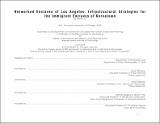Networked enclaves of Los Angeles : infrastructural strategies for the immigrant enclaves of Koreatown
Author(s)
Xu, Wenfei
DownloadFull printable version (226.9Mb)
Alternative title
Infrastructural strategies for the immigrant enclaves of Koreatown
Other Contributors
Massachusetts Institute of Technology. Department of Urban Studies and Planning.
Advisor
Azra Aksamija and Sarah Williams.
Terms of use
Metadata
Show full item recordAbstract
Racial and ethnic segregation has always been physically embedded into Los Angeles. The history of planning within the LA metropolitan area, the development of its highway infrastructure, and the demographic mix are all deeply inter twined. While the construction of the highway system, at its height in the 1940s and 50s, allowed those who had the means to do so freedom to self-segregate, it also reinforced the racial divisions that were created with redlining practices and, thus, created a space of forced enclavization for the inhabitants near the center of the city. The causes of the tensions between the growing Korean community and the black and Latino in this area were myriad and long-simmering, however, much of it was due to growing income inequality, racial biases, cultural and language barriers. Thus, while these ethnic and racial groups lived in physical proximity, enclave behaviors nevertheless prevailed. In the Los Angeles of the present, racial animosity is less directed towards a disenfranchised black population, as many have now moved to the suburbs, but more and more toward immigrant populations with varying degrees of legality. Officially, Los Angeles' Koreatown has a population of 115,000 people, according the 2010 U.S. Census, in its 2.7 square miles, but its size, population, and influence, much like Los Angeles itself, is amorphous and fluid. Despite official boundaries, however, enclaves of ten struggle to form a definite identity and make strong roots. Central to these struggles is most of ten the low income of the people within the community and the inability to develop an economic engine that can form the basis for a strong cultural identity. Through the lens of Koreatown, this project proposes a flexible infrastructural network of links, which aim to connect and strengthen the region as a whole through the legitimization of informal commerce prevalent throughout the area, and nodes, which act as programmatic crossings between one enclave and another.
Description
Thesis: M. Arch., Massachusetts Institute of Technology, Department of Architecture, 2016. Thesis: M.C.P., Massachusetts Institute of Technology, Department of Urban Studies and Planning, 2016. This electronic version was submitted by the student author. The certified thesis is available in the Institute Archives and Special Collections. Cataloged from student-submitted PDF version of thesis. Includes bibliographical references (pages 184-191).
Date issued
2016Department
Massachusetts Institute of Technology. Department of Architecture; Massachusetts Institute of Technology. Department of Urban Studies and PlanningPublisher
Massachusetts Institute of Technology
Keywords
Architecture., Urban Studies and Planning.